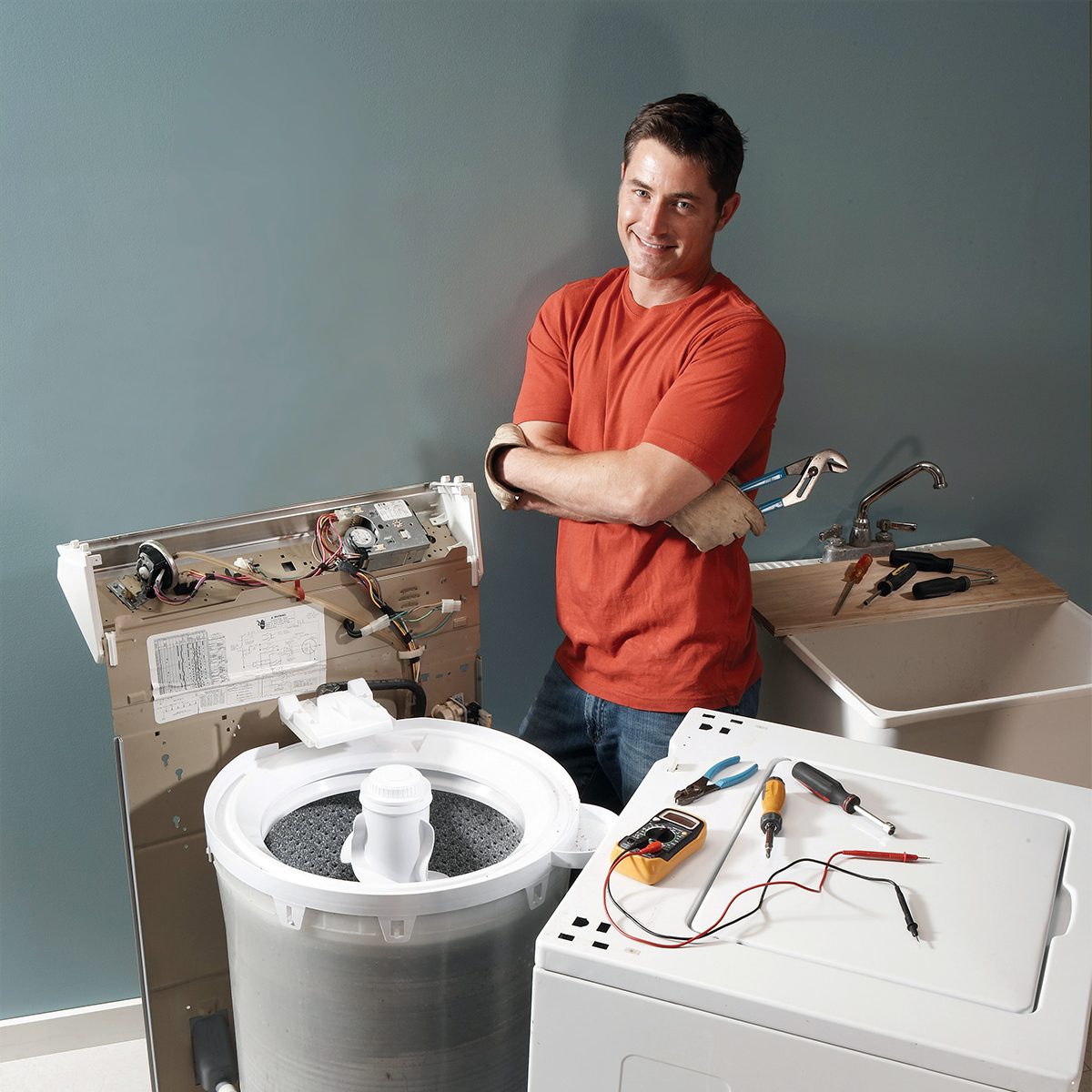
The 4 Most Common Washing Machine Problems and How To Fix Them

It can seem hopeless when any major appliance stops working, but luckily, washing machines are some of the easiest to DIY repair, especially if they’re older.
“Fixing your washing machine is definitely a task that most people, with or without basic mechanical aptitude, can manage,” says appliance repair expert Matthew Morrison. “Two of the most common issues are siphoning of the drain hose, which pulls the water out as it’s filling, and making sure the unit is level, front to back and side to side with an actual level.”
If you have a newer washer, it might even have its own diagnostics, which it will walk you through. But with these more complicated electronics, it’s also important to be a keen troubleshooter.
“Some modern washing machine issues are counterintuitive,” says senior technician Timur Bai. “For example, when the washer is not starting at all, people tend to think about a bad control board, door lock or motor issue. But it usually is something as simple as a clogged drain pump.”
Here’s how to resolve most clothes washer breakdowns, with four easy fixes, including filling and draining problems, grinding noises and a failure to spin. We won’t cover every fix, but the repairs we show will correct about 90 percent of washer troubles, like Maytag or Kenmore washer repairs.
On This Page
Tools and Tips
First, you’ll need a few basic tools, and a multimeter if you need to do any electronic testing. Other tools that are handy to have include:
- Small socket set (most appliances use common size 1/4 inch size bolt heads)
- Plastic putty knife, for releasing clips to not damage the finish
- Bright flashlight
- 10- in-1 screwdriver, to cover a lot of options
- Pair of pliers.
Repairs can take as little as an hour but set aside a full morning to diagnose the trouble, get parts and complete the repair.
Before starting any repair, make sure your washer has power! Unplugged cords and tripped breakers are common causes of appliance “breakdowns.”
Pro-tip: The outer cabinet on some Whirlpool and other brands lifts off completely, giving you access to all the parts. The washer in Maytag and some other brands has removable front and back panels.
How to Access Your Washing Machine’s Parts
Whirlpool-Type Washer

To remove the outer cabinet from this type of washer, first pull off the side trim pieces and remove the retaining screws. Flip the console up and release the spring clips with a screwdriver. Tilt the cabinet forward and lift the cabinet off.
Maytag Washer Repair

To remove the front panel on this type of washer, yank the bottom of the panel outward (you may have to first remove screws). Pull the panel down and out.
With most top-load washers, if you pull the unit forward and lean it against the wall, that is where you will find the drain pump, the drive motor and the belt, if there is one, says Morrison. Most Samsung and LG models are direct drive and have no belt. With front-load washers, you can often remove the back panel or the top without much difficulty to inspect the inner workings.
Also, “At the first sign of an issue or question, use Google search online with a basic search to see if there are comments, common fixes or tutorial videos available for your specific situation,” says Morrison.
Common Washer Machine Problems
Grinding Noise

If you own a Whirlpool direct-drive washer (the water hoses attach to the left side when viewed from the back), you’ve probably got a broken coupler—a common failure caused by overloading the machine. It’s an easy and inexpensive fix.
“The most common mistake is overloading the machine,” says Bai. “Overloading constantly is like driving a fully loaded car uphill with full throttle all the time. The washer may work for a while, but its lifespan is drastically reduced under those conditions.”
Pop the snap retainers with a screwdriver and pull the pump off the motor shaft. Then disconnect the electrical connectors from the motor. Pop the bottom retainer off the motor and prop up the motor while you pop the top retainer (it’s heavy). Pry the broken coupler pieces off the motor and transmission. Tap the new coupler into place with a wooden block.
Draining Problems

The second most common mistake is not checking pockets before putting clothes into the machine, says Bai. “Coins, bills and keys can damage the washer from the inside and often clog or break the drain pump,” he says.
When clothing or jewelry gets stuck in the hose to the pump or the pump itself, the machine won’t drain, and you might hear squealing, grinding or smell burning rubber. First, remove the stuck hose that goes from the tub to the pump (drain the water into a bowl) and check for stuck socks (yes, that’s where they go). Then, run a coat hanger through the tube and pull out the stuck objects. Next, check the pump for broken blades by shaking it.
Rotate the pump shaft to make sure it spins freely. Replace the pump if you find any damage. If you see any burned or melted sections on the belts, replace them. Maytag belts are specially designed, so don’t substitute an ordinary “V” belt.
Slow Fill or No Fill

If your washing machine fills slowly or won’t fill at all, try cleaning the inlet screens on the water valve. If that doesn’t help, replace the entire water valve assembly.
Won’t Agitate or Spin

If the machine fills with water and then just sits there, suspect a broken lid switch. To test the switch, you’ll need a continuity tester or a multimeter. Remove the wires connected to the switch and touch the tester’s probes to the switch’s connectors. As you open and close the lid, readings should alternate between continuity and no continuity. If not, replace the switch.
To replace the switch on a Whirlpool-type washer, just remove the two screws and screw in the new one. To get at the switch on a Maytag-type washer, you’ll have to unscrew the access panel behind the console and replace the switch as shown here. Remember to raise the lid before you remove the old switch.
- Tip: Never drop a washing machine’s lid! Slamming the lid eventually wrecks the lid switch.
FAQs
When should I call a pro to look at my washing machine?
Once you’ve checked all the obvious potential problems, an appliance repair company may be able to connect you with a service technician who can ask a few questions and possibly save you the service trip fee, says Bai. That could be especially helpful if it turns out the washer isn’t worth fixing.
The age of the appliance is also a factor. If the unit is less than 10 years old and you have been happy with the performance, and you don’t feel comfortable doing any type of troubleshooting yourself, you may want to consider calling a professional, says Morrison.
When is a washing machine not fixable?
Sometimes a washer just isn’t worth repairing, like if it’s very old or has specific problems such as a bad drum bearing. You can tell a bad drum bearing from the loud grinding noise it makes while spinning. You may also be able to feel the friction and hear the noise if you turn the drum by hand.
“Although it’s technically doable to replace the bearing, we typically don’t recommend doing that because the repair is very complex, time-consuming and expensive if done by professionals,” says Bai.
How much does it cost to fix a washing machine?
It depends on what’s wrong with it. If you hire a repair service, it will probably run about $100 for them to come and diagnose the problem, though that will probably be absorbed into the total cost of the repair.
Once it is diagnosed, it’s wise to agree on the cost before repairs are made, says Morrison. “The industry standard would be that you pay for any parts and the trip charge upfront, then pay the remaining balance if a return visit is required,” he says.
Also, always ask about warranty on the repairs and try to find an “authorized ” service provider for your specific brand. “An insider tip: contact a local appliance parts store and ask if they have anyone they recommend; often, you will find someone who has plenty of seasoned experience and may have lower labor charges,” says Morrison.
What mistakes may impact the health of your appliance?
Models that are produced and listed as high-efficiency include a tub clean or clean washer cycle, which must be done once a month. Top-load washers that have no agitator and all front-load washers will have this option listed on the control panel.
“This should be done to remove odor-causing bacteria and scrud, which is defined as the buildup of detergents, body oils and any soil that was removed from the clothing,” says Morrison. “Running this cycle proactively will prevent an interruption in your wash, as some models have a set number of cycles, and then you must run the tub clean before running any other cycle.”
Morrison also recommends using Affresh in the clean washer cycle, which is a composite tablet of citric acid and baking soda, and can be found at most supermarkets.
About the Experts
- Timur Bai is a senior technician at My Appliance Crew, an appliance repair company based in Orange County, California.
- Matthew Morrison is an appliance repair expert on JustAnswer, the expert on-demand platform, and prior to that worked as an appliance technician with Sears and GE factory service for almost 20 years.




















